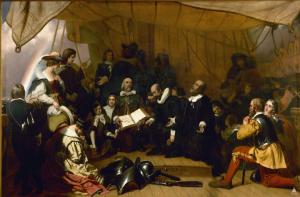“Pilgrim” just has a much nicer ring to most eyes than “puritan.”
On one level, the Pilgrims (who didn’t become the Pilgrims until the early nineteenth century) receive far more attention than they deserve. Every November, school children and many other Americans hear about the brave band of religious refugees who stepped onto Plymouth Rock and then celebrated a First Thanksgiving.

The reality is rather more disappointing. The band was brave, but the rock is tiny and the thanksgiving wasn’t first or even a true day of thanksgiving. If one moves forward, it gets worse. The Pilgrims murdered some nearby Indians, and as the years passed they were key participants in the conquest of southeastern New England.
At least the last sentence points to an important storyline in the history of colonial New England.
For the most part, the Pilgrims have remained the preserve of genealogists, whereas professional historians of early New England keep their eyes fixed on Massachusetts Bay. In his brilliant To Live Ancient Lives, Theodore Dwight Bozeman — one of the more influential interpreters of New England puritanism in recent decades — dismissed “the pathetically unimportant Plymouth church.”
For the uninitiated, the majority of passengers on the Mayflower were “separatists,” men and women who had rejected the Church of England as Antichrist and had withdrawn to form their own congregations. One such congregation moved to Leiden, in the Dutch Republic, where the more moderate separatist John Robinson built a church of several hundred individuals. In the late 1610s, that congregation decided to transplant itself to the New World and after heading off course, ended up establishing the colony of New Plymouth.
Beginning in 1628, a wave of mostly puritan colonists settled Salem, Charlestown, and soon a host of other towns in Massachusetts Bay and Connecticut. Perry Miller labeled these puritans “non-separating congregationalists” because they did not reject the Church of England as a true church. In New England, though, they formed churches very different from the ones they had left, and not only because they set aside what they regarded as the corruptions and idolatries of their mother church, such as the Book of Common Prayer, the surplice, and the sign of the cross. As Edmund Morgan narrated in his Visible Saints, the Massachusetts Bay puritans created something new: congregational churches limited to those men and women who could relate their experience of regeneration. As Morgan noted, this was not a separatist innovation, but a practice developed in the Bay Colony that at least some Plymouth churches embraced.
Not all historians have accepted the marginalization of Plymouth in the history of New England puritanism. (Morgan, like David Hall in the latter’s study of the New England ministry, devoted considerable time to separatism and the Pilgrims before proceeding to narrate events in Massachusetts Bay). Perry Miller, for instance, argued that the Bay colony churches “would have proceeded along essentially the same line had there been no Plymouth at all.” Miller wrote against earlier historians who assigned responsibility for the very emergence of congregationalism in New England to Plymouth’s separatist example.
Recently, Michael Winship has posed a very vigorous challenge to the post-Miller consensus. In his Godly Republicanism, Winship argues that there is no evidence that the Salem colonists came to New England as Congregationalists. One major piece of evidence for Winship’s argument is that there were very, very few committed Congregationalists among English puritan ministers. Two as of the late 1620s, to be precise: the exile William James and the London “semi-separatist” Henry Jacobs. There is no evidence that the ministers who came to Salem in 1629 were “Amesians.” By contrast, seventeenth-century sources assert that they came to New England with no agreement about how to proceed in the formation of churches.
What might have persuaded them to adopt congregational polity? Perhaps New England’s only church, the one at Plymouth, which upheld the “liberties of the people” and the autonomy of the individual congregation. There was significant contact between Plymouth and Salem in the months before the Salem congregants covenanted to form their church. Plymouth’s Samuel Fuller, a self-taught physician and a longtime deacon, went to Salem and convinced its governor, John Endecott, that the Plymouth settlers did not deserve their poor reputation as schismatics. Miller dismissed the idea that a doctor from Plymouth could have decisively influenced the future trajectory of New England puritanism. Likewise, Stephen Foster argued that the Bay colonists “went to Massachusetts fully prepared to realize there the teachings of Non-separating Congregationalism.”
On this precise point, I am somewhat agnostic. It does not seem absurd to me that in the absence of committed Presbyterian-inclined ministers, the Salem colonists would have covenanted with each other to form a particular church. As Francis Bremer has noted in his Lay Empowerment, puritan colonists in Bermuda covenanted to form a church there in a similar manner, sometime before 1617 and without any mission from Deacon Fuller.
Winship’s most convincing argument, however, hinges on subsequent events in Salem. The next year, John Winthrop’s puritan flotilla reached Salem. When the newcomers attended worship, Salem’s ministers barred them from the Lord’s Supper and their children from baptism. With one exception: a man from Henry Jacobs’s London congregation. In other words, the Salem Congregationalists made sacramental access contingent on membership in a particular congregation. Church of England membership did not suffice, because as far as the Salem church was concerned, it was not evidence that one was truly among the godly. Other New England churches then followed this same practice. In other words, the Massachusetts Bay churches did not only turn Congregationalists, they acted very much like separatists despite their disavowals of separatism.
Perhaps because I am writing a book about New Plymouth, I like Winship’s argument if only because one doesn’t want to write about something “pathetically unimportant.” I agree with him on the substance as well. The influence of Plymouth is by far the simplest explanation for the 1629 and 1630 ecclesiastical developments in Salem. In keeping with Edmund Morgan’s Visible Saints, it’s worth noting that the Bay colony’s churches influenced Plymouth in its eventual adoption of stricter membership requirements, which at some point included “relations.”
Winship also makes Plymouth important for the connections he draws between puritanism and arguments against monarchy and the unrestrained exercise of executive authority. That’s an even more important story. For now, it’s worth noting that while Winship’s analysis of pre-1630 separatism and New Plymouth are detailed and persuasive, he also mostly drops Plymouth from his story after 1630. In other words, Plymouth is important for setting Massachusetts Bay on its ecclesiastical trajectory. That leaves an open question: does Plymouth then become “pathetically unimportant” after 1630?













